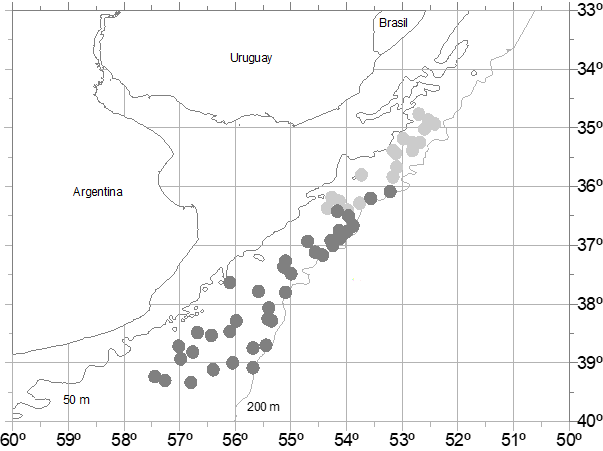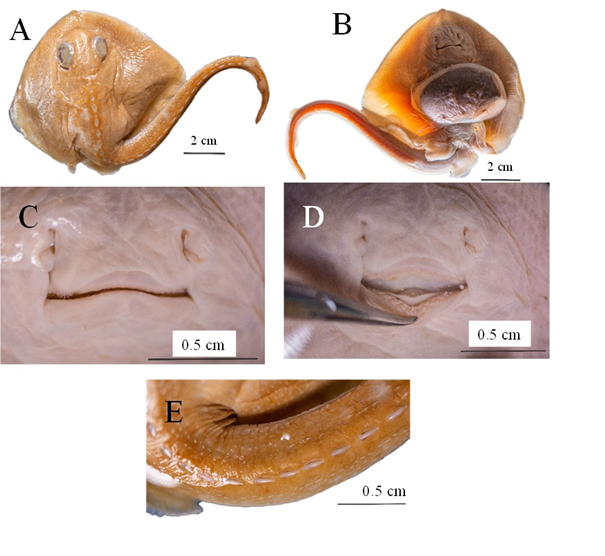International Journal of
eISSN: 2576-4454


Short Communication Volume 7 Issue 4
1Instituto de Ciências Biológicas, Setor de Morfologia, Laboratório de Pesquisa em Chondrichthyes, Universidade Federal do Rio Grande, Brasil
2Dirección Nacional de Recursos Acuáticos - Ministerio de Ganadería Agricultura y Pesca, Uruguay
Correspondence: Maria Cristina Oddone, Universidade Federal do Rio Grande, Instituto de Ciências Biológicas, Setor de Morfologia, Laboratório de Pesquisa em Chondrichthyes, Av. Itália, Km 8 s/n, Campus Carreiros, 96203-900 Rio Grande, RS, Brasil
Received: August 22, 2023 | Published: September 7, 2023
Citation: Oddone MC, Paesch L. Record of an encapsulated embryo of Bathyraja brachyurops captured by bottom trawl off Uruguay, South-West Atlantic ocean. Int J Hydro. 2023;7(4):182-183. DOI: 10.15406/ijh.2023.07.00354
In this note the occurrence of an encapsulated embryo of Bathyraja brachyurops is reported. The embryo was in advanced stage of development. The capsule was collected after a bottom trawl operation, in the Argentinean-Uruguayan Common Fishing Zone, Southwest Atlantic, in September of 2000. After collection, the egg capsule was fixed in formalin 10% and preserved in ethanol 70%. The egg capsule was dark brown and measured 79.0 mm in length and 46.0 cm in width and was opened at its posterior. The embryo was a 100.0 mm total length female with a mass was 5.5 g. The specimen was in advanced development but the yolk sac was still conspicuous. According to the size of the yolk sac and the presence of caudal filament it could be concluded that there were several weeks to go before hatching.
Keywords: developmental biology, skate, elamosbranchs, embryology
The Broadnose skate Bathyraja brachyurops is widely distributed in the Southwest Atlantic, from 36º to 55ºS between 50 to 800 m.1 B. brachyurops is euryphagous and feeds on squid, fish, and crustaceans.2 Particularly, in the Southern sector of the Argentinean and Uruguayan Common Fishing Zone, B. brachyurops is one of the most frequent and abundant species of genus Bathyraja.3
Also, is one of the three most frequently landed skate species from the Uruguayan bottom trawl fishery targeting hake Merluccius hubbsi.3,4 In this sense, from samples obtained from commercial landings, total length at which 50% of the specimens retained by the gear was 68.0 cm and TL50 was estimated at 65.4 cm for males and 67.0 cm for females. B. brachyurops is oviparous and egg capsule length varies from 79 to 91 mm.4
Bathyraja brachyurops inhabits much deeper waters than other skates present in the study area, for this reason, the access to egg capsules and embryos in situ is extremely difficult. In this note, the first record of an embryo B. brachyurops collected in situ by bottom trawl is presented. This is also the first time that morphometrics of an embryo of this species are reported.
The sample came from a cruise carried out in the closed area for juvenile hake in spring of 2000. Fifty-five hauls were made between 34°46'S-39°20'S and 52°25'W-57°27'W, and 51 to 247 m. Bottom temperature and bottom salinity varied between 4.5 - 9.7 °C and 33.6 - 34.2 ppm, respectively. At each sampling location, a 30 min tow was conducted at a towing speed of approximately 3 knots during daylight. A high-opening “Engel” type net with an 80 mm (stretched mesh) codend was used. Trawl stations were selected using a stratified random sampling design, which was defined by depth and latitude (Ehrhardt et al., 1977). The presence of Bathyraja species was recorded in 37 hauls, South of 36°S (Figure 1).

Figure 1 Distribution of the hauls corresponding to the research cruise from where the encapsulated embryo of Bathyraja brachyurops was captured. Grey symbols represent hauls with presence of specimens of Bathyraja spp.; light grey symbols are those hauls where Bathyraja genus was not recorded. The specific haul where the specimen was caught is unknown. The cruise was carried out in spring 2000, off the Rio de la Plata, Southwestern Atlantic Ocean.
After collection, the egg capsule was fixed in formalin 10% and preserved in ethanol 70%. Embryo and egg capsule measurements are in agreement with Clark.5 Total mass was recorded in g including the yolk sac. Measurements were taken with the aid of a caliper to the nearest mm. The egg capsule was dark brown and measured 79.0 mm in length and 46.0 cm in width (Figure 2).

Figure 2 Egg capsule of Bathyraja brachyurops incidentally caught bottom trawl in the Rio de la Plata, Southwest Atlantic, in 2000. Dorsal (A), ventral (B) and lateral (C) view. Photo: Guilherme von Montfort.
The egg capsule was opened at its posterior end and the embryo was partially exposed at the moment of capture. The embryo was a 100.0 mm total length female (Figure 3). Total mass was 5.5 g.

Figure 3 Embryo of Bathyraja brachyurops incidentally caught by bottom trawl in the Rio de la Plata, Southwest Atlantic, in 2000. Dorsal view (A), ventral view, with yolk sac (B), detail of the mouth (C), detail of the opened mouth displaying teeth (D) and proximal region of the tail in caudal view. Photo: Guilherme von Montfort.
The specimen was in advanced development but the yolk sac was still conspicuous. The caudal filament was present. External gills were absent. Morphometric measurements taken from the specimen are shown in the Table 1. There are not published records of experimental studies of the size at hatching of B. brachyurops but according to the size of the yolk sac and the presence of caudal filament it could be concluded that there were several weeks to go before hatching. According to Stehmann and Merrett,1 the egg capsules of true deepwater skates are infrequently found, and unlike those of shelf-dwelling and eurybathic skate species empty egg capsules are rarely washed ashore. For this reason, the specific identification of such capsules, empty or filled with yolk and a very early embryo, is extremely difficult and the majority cannot be assigned with certainty to a species. These authors recorded 16 egg capsules of Bathyraja richardsoni (Garrick, 1961) in one trawl haul, in the Porcupine Seabight, North-eastern Atlantic. Five contained embryos, four of which were at advanced stages of development and more or less close to hatching. For the Southwest Atlantic, Soto and Costa,6 reported the occurrence of an egg capsule with an embryo of Rajella sadowskii (Krefft & Stehmann, 1974), collected by bottom trawl, in situ.7–11
|
Sex, mass and measurements |
|
|
Sex |
female |
|
Mass |
5.5 |
|
Total length |
100 |
|
Disc length |
40 |
|
Disc width |
48 |
|
Snout length |
8 |
|
Interorbital width |
6 |
|
Snout to tip of pelvic fin |
42 |
|
Snout to anterior margin of cloaca |
53 |
|
Tail length from anterior margin of cloaca |
60 |
|
Second dorsal to tail tip |
14 |
|
Preoral snout length |
11 |
|
Internasal width |
7 |
|
Prenasal snout length |
8 |
Table 1 Mass (g) and morphometric measurements (mm) for the encapsulated embryo of Bathyraja brachyurops captured by bottom trawl off Uruguay, South-west Atlantic Ocean, in 2000
None.
There is not any conflict of interest.

©2023 Oddone, et al. This is an open access article distributed under the terms of the, which permits unrestricted use, distribution, and build upon your work non-commercially.